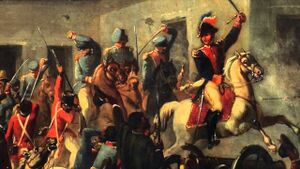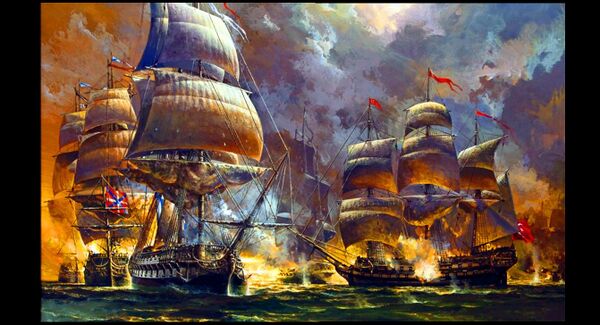Polaches-Juarez War: Difference between revisions
ContraViper (talk | contribs) No edit summary |
ContraViper (talk | contribs) |
||
| Line 48: | Line 48: | ||
==Juarez Campaign== | ==Juarez Campaign== | ||
In retaliation for Vargas' raids, the government of Grande Inyursta sent Admiràle Fernando | In retaliation for Vargas' raids, the government of Grande Inyursta sent [[Fernando Valízeno|Admiràle Fernando Valízeno]] with a small force of ships to strike Cuscatlani settlements in the northern province of Zavala along the coast of the Sea of Juarez. Valizéno had only a handful of ships, many of which were schooners and blockade runners rather than true frigates ands man-of-wars. | ||
The Inyurstan navy had early success in striking back at Cuscatlani ports and seaside communities. While the Inyurstan naval force was small, the Cuscatlanis had almost no capable naval vessels in the Sea of Juarez, and instead enlisted the services of privateers to engage Valizéno's warships and attack Inyurstan supply lanes. Ironically, some crews of the Inyurstan flotilla had been pirates or privateers prior to accepting pardons and commissioning into the navy, including [[Enriqué D'Andalucia|Captain Enriqué D'Andalucia]] who was the former first mate of [[Philipé Cousteau]] who served as a captain under Valizéno. | The Inyurstan navy had early success in striking back at Cuscatlani ports and seaside communities. While the Inyurstan naval force was small, the Cuscatlanis had almost no capable naval vessels in the Sea of Juarez, and instead enlisted the services of privateers to engage Valizéno's warships and attack Inyurstan supply lanes. Ironically, some crews of the Inyurstan flotilla had been pirates or privateers prior to accepting pardons and commissioning into the navy, including [[Enriqué D'Andalucia|Captain Enriqué D'Andalucia]] who was the former first mate of [[Philipé Cousteau]] who served as a captain under Valizéno. | ||
Latest revision as of 14:05, 16 February 2022
| Polaches-Juarez War | |||||||
|---|---|---|---|---|---|---|---|
 General Vargas attacks Saint Dijon. | |||||||
| |||||||
| Belligerents | |||||||
|
Supported by Zavalac Tribes |
Supported by Privateers | ||||||
| Commanders and leaders | |||||||
|
|
| ||||||
| Strength | |||||||
| 4,200 Inyurstan regulars, 700 Zavalac Warriors (est) | 1,500 Cuscatlani regulars, 3,800 Militia, 6 Privateer Crews (est) | ||||||
| Casualties and losses | |||||||
|
Grande Inyursta |
Cuscatlan | ||||||
The Polaches-Juarez War was a short military conflict between the republic of Grande Inyursta and the early Federation of Cuscatlan. El Caudillo-General Antonio Lopez saw the Spanish support of Inyurstan rebels in the Inyurstan Uprising of 1836 as well as the subsequent Treaty of Nuveau Lyon which allowed France & Spain to move through the Sea of Juarez and access their mainland colonies as a direct threat to Cuscatlan and began to attack mainland Inyurstan cities and settlements in the Southern Territories. Some critics also argue that Lopez saw the potential to annex the Southern Territories in part with Cuscatlani manifest destiny.
Vargas' Raids
In March of 1839, an army of Cuscatlani irregulars (comprised mostly of Llaneros and Cayua Indians) moved across the border into Inyursta along the Ochaca Rainforest and Sea of Juarez. Under the cover of darkness they ransacked and pillaged the former French settlement of Mirasousse. Less than a week later General Joao Vargas led a force north from Paratapais through the Bosque Verté Rainforest and attacked Saint Dijon (now Sant Dij'oa). Little resistance was given, and Saint Dijon was burned and the ships in port looted and sunk. Lopez then pushed along the coast towards Guadalojas.
Meanwhile, General Bernado Lafayette was assigned control of the defense of Inyursta. He mobilized an initial force of around 1,000 and moved via ship towards Guadalojas. A tropical depression forced Lafayette to land early on the mainland side of the Straits of Hidalgo, while Vargas' light assaulted a on foot only suffered minor delays. When Vargas arrived at Guadalojas he encountered much more resistance than previous settlements. His forces repeatedly attacked the city, and were repelled several times, but eventually broke the Inyurstan defenses and subsequently sacked and raised the city. Lafayette arrived too late to relieve Guadalojas but his arrival forced Vargas into a temporary withdrawal.
Lafayette then set up his HQ in what was left of the city and sent word for more reinforcements.
Juarez Campaign
In retaliation for Vargas' raids, the government of Grande Inyursta sent Admiràle Fernando Valízeno with a small force of ships to strike Cuscatlani settlements in the northern province of Zavala along the coast of the Sea of Juarez. Valizéno had only a handful of ships, many of which were schooners and blockade runners rather than true frigates ands man-of-wars.
The Inyurstan navy had early success in striking back at Cuscatlani ports and seaside communities. While the Inyurstan naval force was small, the Cuscatlanis had almost no capable naval vessels in the Sea of Juarez, and instead enlisted the services of privateers to engage Valizéno's warships and attack Inyurstan supply lanes. Ironically, some crews of the Inyurstan flotilla had been pirates or privateers prior to accepting pardons and commissioning into the navy, including Captain Enriqué D'Andalucia who was the former first mate of Philipé Cousteau who served as a captain under Valizéno.
After several feints and partial pursuits, the Inyurstan Navy finally squared off with Cuscatlani privateers off the coast of Zavala near the port town of Santa Cruz. Both sides maneuvered around the better part of the battle trying line up the best position, and neither side could garner the advantage. Admiràle Valizéno eventually fought off the enemy privateers, but lost four of his own vessels with others left damaged and was forced to retreat to repair his ships and be ready to defend Inyursta in case of a counter-attack.
To keep continued pressure on the Cuscatlani settlements on the Sea of Juarez, Inyurstan agents worked with both smugglers and Spanish authorities out of Nueva Aragua to arm local Zavalac Amerindians, who in turn continued raids from the landward side of Zavala.
Sierra Polaches Campaign
While setting up camp in Guadalojas, Lafayette had requested and gathered reinforcements. He had amassed an army of around 3,200 Inyurstan regulars, before he broke headquarters and marched on the province of Paratapais, where El Caudillo Lopez governed from. Historical records indicate that the Inyurstan command at the time believed the Cuscatlanis would expect a counter-offensive through the lowlands of the Bosque Verté rainforest, and looked for alternate methods of incursion. General Lafayette erronously decided that marching through the highlands of the Sierra Polaches was the best course of action.
What Layafette and his staff did not anticipate was the dissimilar terrain of the Sierra Polaches. An army that had packed light and been used to crossing deep slow-moving rivers and navigating thick, muddy jungles had a hard time moving equipment up steep mountain slopes, fording fast-moving white-water and bearing through the frigid Sierran nights. Progress was slow, and word was able to reach the Cuscatlanis that Layafette was on his way. Lopez quickly mobilized his standing army, and led the forces himself into the mountains to meet Layafette head-on. Unlike the Inyurstans, the Cuscatlanis had anticipated the mountain march, and prepared accordingly with what little time they had. Lopez was able to cover the same distance as his opponent had in half the time, and rallied more irregular auxiliaries to his cause.
The two armies met at what is now the border between Inyursta and Corruguay province just a few hundred meters below the snow belt. Entrenched Cuscatlanis held the advantage over the Inyurstans of approximately equal number, but the Inyurstans had managed to lug significantly more cannons and horses up hill, giving them more calvary and better field artillery coverage. Layafette concentrated all his cannon fire on the center of the Cuscatlani lines, before sending in a calvary charge to spearhead a general advance by the infantry. This managed to break Lopez's center lines and the Inyurstan calvary regiments fanned out behind them to strike the Cuscatlani encampments while the infantry moved through the gap to exploit the hole created. Ironically, the sucess of the calvary charge played into Lopez's hands as it allowed his own auxiliaries to sweep down from the mountains in small-numbered groups and strike the Inyurstan line which was now spread thin as the column advanced into Cuscatlani ground. Due to the poor battlefield communication capabilities of the day, the situation quickly devolved into disorganized chaos and severe close combat in several locations. Because of the mixed composition and close quarters fighting, the Inyurstan cannons were unable to fire at anything beyond self-defense. At the end of the day casualties were high on both sides, and with Layafette's initiative broken the Inyurstans were unable to push into Cuscatlan.
Closure & Legacy
Following the stalemate in the Sierra Polaches, both sides pushed for peace. In late September of 1842, delegations of Grande Inyursta and Cuscatlan - including General Vargas and Admiral Valizéno - met in San Torres and subsequently signed the Treaty of San Torres. This treaty guaranteed Grande Inyursta would cease supplying arms to rebel Zavalac Amerindians and a promise they would not allow Spanish or Portuguese merchant companies (or soldiers) in the Southern Territories; in return the Cuscatlanis would recognize the Southern Territories as Inyurstan.
Most historians and military analysts agree that the Polaches-Juarez War was a draw, considering both sides accomplished little and fought to stalemates on both fronts. However, in terms of public opinion, many Inyurstans and Cuscatlanis believe their side won the war. Cuscatlanis will point to a defeated invasion of Paratapais and stalemate on the high seas as proof their side won; likewise Inyurstans will point to the fact they effectively stopped General Vargas's raids and managed to keep control of the Southern Territories.,
